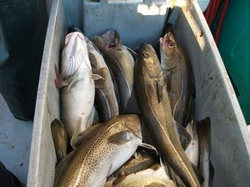
The Internet has been a great tool for anglers; it’s a great source for weather, tides, products and fishing reports. Many fishing websites allow fisherman to post their personal reports along with images. Social media sites such as Facebook and Twitter are also full of great fishing images and anglers showing off their catch.
The recreational fisherman is already in the “cross hairs” of groups like P.E.T.A. and Greenpeace. Our own country’s energy policies have made a day out on the water fishing and boating an expensive one, not to mention the unknown effects of E15 gasoline on our marine engines.
When surfing the web, especially sites that allow posting of reports and images, I am often amazed by fishing photos submitted by fellow anglers which show our sport in a poor light. I am sure that many readers have seen the recreational blood bath photos or are familiar with photo of the 120 quart cooler overflowing with Cod. These images may be great for the poster’s ego; however, such photos may easily be used against our sport. As a webmaster of Skimmeroutdoors, I exercise discretion regarding the images posted on the site. In fact, throughout the years, I have received many images which I have chosen not to post because such images had the potential to make our recreational fishing appear barbaric. Even with such a review process, I realize that there may be some images our site that others may view unfavorably,
Once you post an image on the web, you have lost control of the content forever, so be careful what you upload. Well organized groups such as the aforementioned P.E.T.A. and Greenpeace have volunteers scouring the Internet for images which may be used to promote their agenda.
Here are some steps you can follow to ensure that your photos cannot be used to support the anti-fishing agenda.
- When taking a photograph of an angler and their catch, take the time to rinse the fish off with seawater to remove any blood. This will also make the fish look fresh, improving the appearance of the catch.. Secondly, anglers should follow this rule as well, and should wash down their skins and make sure they are clean for photos.
- Look beyond your subject and make sure the deck is not full of blood and fish. Try to shoot using the water as your background (not your driveway), and use the flash even on a sunny day to fill in any shadows.
- If you send your photos to magazines to be published, you will have a much better chance if the subject posing with the catch has a neat appearance, for example he or she should not be smoking a cigarette or wearing a sweatshirt on with advertising is printed.
By following these common sense rules we can not only take better photos, but more importantly , we can help to protect the reputation and perception of recreational fishing from those that would prefer to damage or tarnish this wonderful pastime.
Tim C. Smith


 RSS Feed
RSS Feed